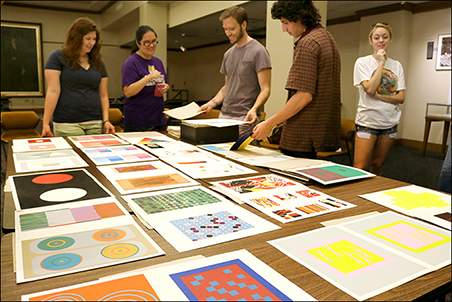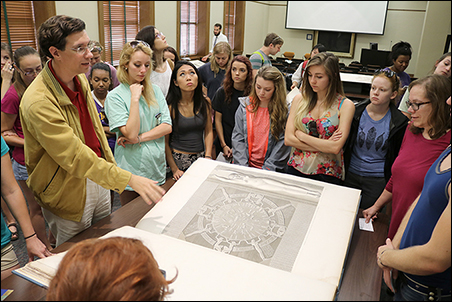Rare books enrich students' classroom experience
Love Digital, Live Analog. That was the theme of a recent class visit to Special Collections. Doctoral students in Music 7800 (Introduction to Research in Music) have an assignment to research something from our collections that relates to music.
 Curator of Books Michael Taylor gave them a crash course on how to be “history detectives.” What can we learn by looking at different editions of the same book? What does a book's size, format, and design tell us that its text might not? How can inscriptions and other evidence of reading change our perceptions of an author or text?
Curator of Books Michael Taylor gave them a crash course on how to be “history detectives.” What can we learn by looking at different editions of the same book? What does a book's size, format, and design tell us that its text might not? How can inscriptions and other evidence of reading change our perceptions of an author or text?
Can looking at historical objects side-by-side raise questions that we might not think to ask otherwise? For example, one group of students looked at two Mozart scores, a libretto for Don Giovanni, and a biography of Haydn. Discovering that all of the books were printed or used in the United States (including Louisiana) in the early 1800s, they realized they could write a paper about how European composers came to be known on this side of the Atlantic.
In the photo above, students are looking at a French gradual (sacred music book), printed in 1778, and discussing how it might have been used.
Object-based learning has been part of several other classes this semester, including Art 1849 (Introduction to Painting), which viewed Josef Albers' The Interaction of Color. The class also studied a related recent acquisition, Who Stole the Tarts? This one-of-a-kind book of silkscreen prints is an artistic rendition of Chapter 12 of Lewis Carroll's Alice's Adventures in Wonderland. It was made in Germany earlier this year by artists Anna Hellsgard and Christian Gfeller, who have ensured that their artistry exists on a global scale by not allowing any institution to purchase more than one volume of the multi-volume book.
Professor Darius Spieth has brought two of his classes, Interior Design 4741 (History of Interior Design) and Honors 2021 (Art and Colonialism), to view several gargantuan volumes of prints from the Description de l'Egypte. Commissioned and funded by Napoleon Bonaparte, the book is a record of the scientific expedition that traveled with the French army in the Middle East in 1798-1801. The team of explorers is credited with, among other things, discovering the Rosetta Stone, later used to decipher Egyptian hieroglyphics. The book also set off a short-lived craze for Egyptian-themed design in Europe and the United States.
Students from Spieth's honors course will each be researching one print from the Description de l'Egypte and presenting on it to their class later this semester.
To learn about how you can bring your class to Special Collections and make hands-on work with rare books and archival materials part of your students' classroom experience, please contact us!


